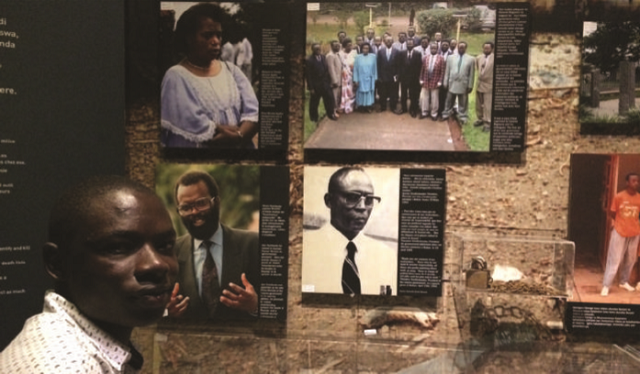
The traffic to Kigali Genocide Memorial in Gizozi is now considerably big, considering the fact that this is a time several family members and friends visit the memorial site to lay wreaths of flowers on the graves, and pray for loved ones who lost their lives during the genocide.
The memorial’s architectural design embodies what a genocide memorial site should be: not a place to laugh but a place to share in the sadness of what happened 23 years ago this month.
In 2001, in collaboration with Rwanda’s National Commission for the Fight Against Genocide (CNLG), the Aegis Trust raised the $2 million required to build the memorial. The centre was officially opened on 7 April 2004 to mark the tenth commemoration of the 1994 genocide against the Tutsi in Rwanda.
The memorial is the final resting place for up over 250,000 victims of the genocide and serves as a place where people can grieve for their lost loved ones and remember them. It also serves as a museum where both local and international visitors can learn about the history, implementation and consequences of the genocide.
The centre documents the genocide, but it also describes the history of Rwanda that preceded the event. Comparisons are also made with similar sites in Germany, Japan, Cambodia and Bosnia. Unlike the ex-concentration camps at Auschwitz Birkenau, the Rwanda site includes human remains and the tools and weapons used in their destruction.
The upstairs floor of the centre includes three permanent exhibitions, the largest of which documents the genocide in 1994, helping to give Rwanda’s nightmare a historical context. There is a children’s memorial, with life-sized photos, accompanied by intimate details about their favorite toys, their last words and the manner in which they were killed. There is also an exhibition on the history of genocidal violence around the world. The Education Centre, Memorial Gardens and National Documentation Centre of the Genocide contribute to a meaningful tribute to those who perished and form a powerful educational tool for the next generation.
The Kigali Memorial Centre is international. It deals with a topic of international importance, with far-reaching significance, and is designed to engage and challenge an international visitor base.
Although it’s only one of the several physical spaces devoted to commemorate those killed in the genocide, it’s definitely the most important in Rwanda. Apart from mass graves located in its gardens, where over 250,000 bodies are interred, the memorial also houses the Genocide Archive Rwanda, together with the history of Rwandan genocide plus other genocides that have happened all over the world.
So how does the Kigali Genocide Memorial architecture reflect the mood of the killings?
According to Otieno Nondoh, a lecturer at the design department, University of Rwanda, the architectural design of the memorial should reflect the mood of why it was built in the first place.
Nondoh says that in a world where conflicts and atrocities still continue to occur, there’s a risk that construction of memorials has become occasions and monuments for rhetorical ceremonies. “But the strong emotional impact that such kinds of places share a will to remember, is, however, undeniable,” he says.
.According to Pierre Nora, whose Les Lieux de Mémoire describes places that ‘are fundamentally remains, the ultimate embodiments of a memorial consciousness sites of memory are artificial and deliberately fabricated. Their purpose is ‘to block the work of forgetting’ but there is not a univocal way of building them.
When you enter Kigali Memorial, your consciousness is going to be pricked just by its architectural design. You first walk along the ground floor, where the history of Rwanda genocide is well documented by reading the literature on its walls, and what strikes you are the mood of darkness that the designers of the building created.
Nondoh says that the mood of darkness resonates with what a memorial site should be: “It’s a place you retreat for reflection. The theme should, therefore, reflect the mood of mourning, and darkness itself aptly represents this mood,” he says.
And as Pat Caplan puts it, in Rwanda ‘there is no single or “right” way of memorialising the dead of a genocide or of creating public monuments’. This might be why Aegis Trust and the National Commission for the Fight Against Genocide consulted a team of international architects about how to deal with Rwanda’s central place of memory.
Nondoh adds that a memorial site like in Kigali invites reflection whether it can provide architectural answers to tragedies afflicting humanity.
“This is a question appearing ever more often, as structures paying tribute to victims of massacres and disasters increase in number, and to which Kigali Genocide Memorial provides an interesting solution, mixing the iconic amphitheatre form with abstraction plus space-making strategy of its landscape environment and setting.”
****
editor@independent.co.ug
 The Independent Uganda: You get the Truth we Pay the Price
The Independent Uganda: You get the Truth we Pay the Price



